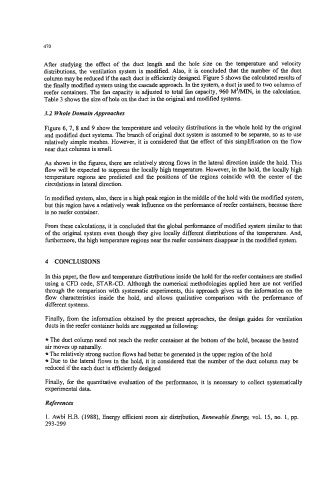Page 495 - Practical Design Ships and Floating Structures
P. 495
470
After studying the effect of the duct length and the hole size on the temperature and velocity
distributions, the ventilation system is modified. Also, it is concluded that the number of the duct
column may be reduced if the each duct is efficiently designed. Figure 5 shows the calculated results of
the finally modified system using the cde approach. In the system, a duct is used to two columns of
reefer containers. The fan capacity is adjusted to total fan capacity, 960 M3/MTN, in the calculation.
Table 3 shows the size of hole on the duct in the original and modified systems.
3.2 whole Domain Approaches
Figure 6, 7, 8 and 9 show the temperature and velocity distributions in the whole hold by the original
and modified duct systems. The branch of original duct system is assumed to be separate, so as to use
relatively simple meshes. However, it is considered that the effect of this simplification on the flow
near duct columns is small.
As shown in the figures, there are relatively strong flows in the lateral dmtion inside the hold. This
flow will be expected to suppress the locally high temperature. However, in the hold, the locally high
temperature regions are predicted and the positions of the regions coincide with the center of the
circulations in lateral direction.
In modified system, also, there is a high peak region in the middle of the hold with the modified system,
but this region have a relatively weak influence on the performance of reefer containers, because there
is no reefer container.
From these calculations, it is concluded that the global performance of modified system similar to that
of the original system even though they give locally different distributions of the temperature. And,
furthermore, the high temperature regions near the reefer containers disappear in the modified system.
4 CONCLUSIONS
In this paper, the flow and temperature distributions inside the hold for the reefa containers are studied
using a CFD code, STAR-CD. Although the numerical methodologies applied here are not verified
through the comparison with systematic experiments, this approach gives us the information on the
flow characteristics inside the hold, and allows qualitative comparison with the performance of
different systems.
Finally, from the information obtained by the present approaches, the design guides for ventilation
ducts in the reefer container holds are suggested as following:
The duct column need not reach the reefer container at the bottom of the hold, because the heated
air moves up naturally.
The relatively strong suction flows had better be generated in the upper region of the hold
Due to the lateral flows in the hold, it is considered that the number of the duct column may be
reduced if the each duct is efficiently designed
Finally, for the quantitative evaluation of the performance, it is necessary to collect systematically
experimental data.
References
1. Awbi H.B. (1988), Energy efficient room air distribution, Renewable Enew, vol. 15, no. 1, pp.
293-299

